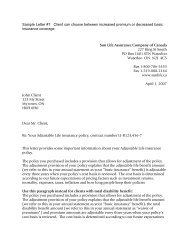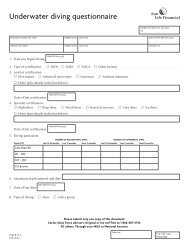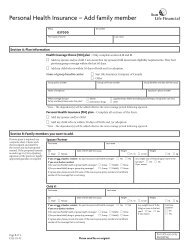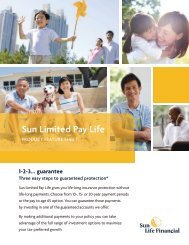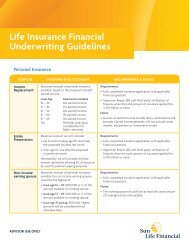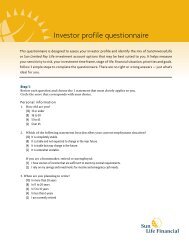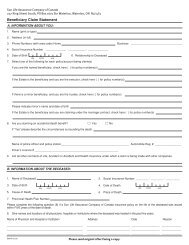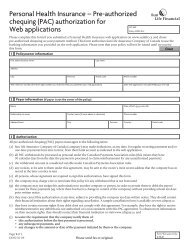Shared Ownership of Critical Illness Insurance - Sun Life Financial
Shared Ownership of Critical Illness Insurance - Sun Life Financial
Shared Ownership of Critical Illness Insurance - Sun Life Financial
You also want an ePaper? Increase the reach of your titles
YUMPU automatically turns print PDFs into web optimized ePapers that Google loves.
<strong>Shared</strong> <strong>Ownership</strong> <strong>of</strong> <strong>Critical</strong> <strong>Illness</strong><strong>Insurance</strong>January 4, 2010Prepared by Affluent Market Solutions<strong>Sun</strong> <strong>Life</strong> <strong>Financial</strong>
<strong>Shared</strong> ownership <strong>of</strong> critical illness insurance – suggestions formaking every sale a good oneSales <strong>of</strong> critical illness insurance (CII) with shared ownership have been gaining momentum since thelaunch <strong>of</strong> the new product in January 2009. With the strong interest in CII, and in the sharedownership strategy, this paper will review some <strong>of</strong> the things you need to know to ensure the success<strong>of</strong> each CII shared ownership sale you make. While the shared ownership concept appears simple onthe surface, there’s a bit more to it than meets the eye.Key Principles <strong>of</strong> CII <strong>Shared</strong> <strong>Ownership</strong>Ensure a need for critical illness coverage existsLike any business strategy, the corporation must need CII coverage on the employee or shareholder.Some individuals are vital to the success <strong>of</strong> an organization. Losing that person’s ideas and businessexperience as the result <strong>of</strong> a critical illness can have devastating short- and long-term financialimpacts on the business. Work directly with clients to help demonstrate the value <strong>of</strong> the keyemployees and shareholders, and help identify the need for CII before presenting this strategy.Clients should obtain independent tax and legal adviceOne <strong>of</strong> the advisor’s responsibilities is to make sure that both the corporation and the insuredunderstand the importance <strong>of</strong> getting their own tax and legal advice to make sure that this strategymeets their needs:• The CII shared ownership strategy, while attractive to many, may not be suitable for allparties.• This strategy provides only one benefit. Therefore, while two separate parties are payingpremiums under the shared ownership agreement, only one <strong>of</strong> the parties will receive abenefit. In all cases, either the corporation will receive the CII benefit or the insured willreceive the Return <strong>of</strong> Premium (ROP) benefit.Highlight the importance <strong>of</strong> the "behind the scenes" responsibilitiesIn addition to providing advice, the parties’ lawyers will also work “behind-the-scenes” to help theparties put the strategy into place. They will draft a corporate resolution for the board <strong>of</strong> directors topass to allow the corporation to buy the insurance and agree to the strategy, and will draft a sharedownership agreement for the parties to sign (see below). They will also guide the parties whenimportant decisions affecting the agreement need to be made.Put a shared ownership agreement in placeThe parties will need to have a written shared ownership agreement in place to record their rights andobligations, and to support the validity <strong>of</strong> this strategy. If desired, the agreement may be put in placeafter the insurance has been issued to avoid wasting the cost <strong>of</strong> producing the agreement if for anyreason the policy cannot be issued. There are many issues that the agreement should cover. Hereare some <strong>of</strong> the key issues, although this is not an exhaustive list:• The allocation <strong>of</strong> premiums and benefits• Terminating the agreement (including what to do at cancellation or expiry <strong>of</strong> the policy)• What happens if the employee’s employment ends or if the shareholder leaves thecorporation (i.e., death, resignation, retirement)• How a buy-sell agreement impacts the shared ownership agreement• What happens if the corporation is wound up, goes bankrupt or becomes insolvent© <strong>Sun</strong> <strong>Life</strong> Assurance Company <strong>of</strong> Canada, 2010. Key Principles <strong>of</strong> CII <strong>Shared</strong> <strong>Ownership</strong> – Page 1
Recording the policy on our system as a shared ownership arrangement is notenoughClients should work directly with their legal and tax advisors to ensure that they have a written sharedownership agreement. Recording the policy on our system as a shared ownership arrangement doesnot mean that there’s a legally valid shared ownership agreement in place. Clients’ legal and taxadvisors can refer to the outline <strong>of</strong> a sample shared ownership agreement on our website forreference.Plan for tax consequencesAs with all types <strong>of</strong> sales strategies, tax planning is a key component to the success <strong>of</strong> the strategy. ACII shared ownership strategy is no different. Here are two tax planning aspects that should beconsidered before implementing this strategy:• There are product tax issues that may arise outside <strong>of</strong> the CII shared ownership strategy.Currently, there are no laws governing the tax treatment <strong>of</strong> CII. We rely on Canada RevenueAgency CRA guidance to determine the tax treatment <strong>of</strong> these policies. However, thatguidance is not binding on the CRA – it could change at any time.• There are also tax issues that arise from the relationship between an employee orshareholder and his or her corporation. Unlike the situation governing the tax treatment <strong>of</strong> CIIproducts, the laws governing the tax treatment <strong>of</strong> employee and shareholder benefits are wellestablished in the Income Tax Act (ITA), court decisions and CRA guidance. Even if youconclude that no tax consequences arise from the payment <strong>of</strong> a CII benefit to the policyowner(s) that does not end the discussion. Tax consequences may still arise based on therelationship between the employee or shareholder and the corporation.Understand that the corporation is a separate legal entityIt is important to remember that a corporation is considered a separate legal person distinct from itsshareholder or shareholders, and that the CRA may treat the corporation this way. Here are some <strong>of</strong>the tax matters that may arise from this distinction:• If the insured is a controlling shareholder or someone else who doesn’t deal at arm’s lengthwith the corporation, and unilaterally cancels the shared ownership CII policy to collect theROP benefit, the CRA may say that the shareholder has received a benefit from thecorporation even though the corporation has not done anything to actually confer that benefit.The CRA may assert that the corporation agreed to cancel coverage because theshareholder controls the corporation, not because cancelling coverage was a sound businessdecision for the corporation (see discussion under the section, “Make clients aware <strong>of</strong>potential tax and legal issues”).• If a shareholder deals at arm’s length with a corporation, though, the CRA acknowledges thatyou need to have the corporation agree to transfer something <strong>of</strong> value to the shareholder inorder to say that the corporation has conferred a benefit on the shareholder. If theshareholder transfers something <strong>of</strong> value to himself or herself without the corporation’sagreement, then there could be inappropriate conduct like theft, embezzlement, fraud ormisappropriation <strong>of</strong> funds.Make clients aware <strong>of</strong> potential tax and legal issuesAs an advisor, you need to make clients and their legal and tax advisors aware that there are tax andlegal issues arising from a CII shared ownership arrangement. You do not have to resolve theseissues for the client; after all, you cannot provide tax and legal advice. But a client’s legal and taxadvisors need to discuss these matters with the client, and need to provide advice about thedecisions the client should make. Here are some <strong>of</strong> the issues they need to discuss (though not anexhaustive list). A taxable benefit to an employee or a shareholder may arise when:• The corporation pays premiums for individual CII coverage on the employee, but the benefitsare paid to the employee directly. There may be situations involving variations <strong>of</strong> theemployer/employee relationship that may allow for different tax treatment.© <strong>Sun</strong> <strong>Life</strong> Assurance Company <strong>of</strong> Canada, 2010. Key Principles <strong>of</strong> CII <strong>Shared</strong> <strong>Ownership</strong> – Page 2
• The corporation pays premiums for individual CII coverage on the shareholder, but thebenefits are paid to the shareholder directly. The corporation cannot deduct the premiumcost, resulting in double taxation on the dollars used to pay for this coverage.• The corporation transfers ownership <strong>of</strong> a CII policy to an employee or shareholder, but theemployee or shareholder does not pay for the policy, or pays less than fair market value.• In a shared ownership arrangement between a corporation and a shareholder, theshareholder unilaterally cancels the CII policy. The shared ownership agreement should setout procedures for cancelling the CII policy that protect both parties’ interests and which helpto confirm the legitimacy <strong>of</strong> the agreement. For example, under <strong>Sun</strong> <strong>Life</strong> <strong>Financial</strong>’s outline <strong>of</strong>a sample CII shared ownership agreement, if the shareholder wants to cancel coverage he orshe must notify the corporation. The corporation then has the right to maintain the policy inforce, if desired. If the shareholder ignores the corporation’s rights, cancels coverage andreceives the return <strong>of</strong> premium benefit, the CRA could regard the return <strong>of</strong> premium as ashareholder benefit because the shareholder denied the corporation an opportunity to protectits rights under the agreement. As discussed above, even if the shareholder controls thecorporation, the CRA will treat the corporation as a separate legal person with rights that theshareholder cannot ignore.Be aware <strong>of</strong> issues unique to sole shareholdersThe tax situation for sole shareholders may be more involved than many people think. Here are somethoughts:• The CRA taxes benefits to shareholders under the Income Tax Act (ITA s. 15(1)). The CRAtreats a shareholder benefit as something paid by the corporation not to earn income, butbecause the shareholder owns shares in the corporation. Therefore the benefit will be taxedas income to the shareholder, but the corporation will not be able to deduct the value <strong>of</strong> thebenefit as a business expense.• Whether a corporation has conferred a benefit on a shareholder under ITA s. 15(1), what thatbenefit is, and the value <strong>of</strong> that benefit, are all questions <strong>of</strong> fact in each case. Generally, theCRA’s position is that any transfer <strong>of</strong> property or payment <strong>of</strong> money from a corporation to ashareholder, or use <strong>of</strong> corporate property by a shareholder, is a shareholder benefit.• Here are some <strong>of</strong> the issues that arise in such cases:• In order to be characterized as an employee benefit, there must be a reasonablebusiness purpose for the benefit. It has to make good business sense for thecorporation to spend the money. In our case, a CII shared ownership arrangementneeds to be a reasonable business transaction that benefits both parties.• It could help persuade the CRA that a shareholder is receiving an employee benefit ifnon-owner employees are receiving the same or proportionate benefits. If the benefitsare not equal, differences in size should reasonably express the value <strong>of</strong> thecontributions that individuals are making to the corporation. If the shareholder’s benefitsare disproportionately large compared to those the non-owner employees receive, theCRA may conclude that the shareholder has received larger benefits because he orshe owns shares in the corporation, not because the shareholder’s services are somuch more valuable to the corporation.• The benefit must be “conferred”. However, as discussed above, in sole shareholdersituations, the CRA does not care whether the corporation has done anything t<strong>of</strong>ormally confer the benefit. If a sole shareholder receives something <strong>of</strong> value from thecorporation, or uses corporate assets for his or her own benefit, the CRA may assumethat the corporation agreed to the transaction. In cases where the shareholder deals atarm’s length with the corporation, the CRA may want to see the documentationsurrounding the benefit to help it make a determination.• A shareholder benefit enriches the shareholder to the same extent that it financiallydiminishes the corporation. In contrast, an employee benefit does not financiallydiminish the corporation because the corporation receives services from the employee<strong>of</strong> equal value to the employee benefit.© <strong>Sun</strong> <strong>Life</strong> Assurance Company <strong>of</strong> Canada, 2010. Key Principles <strong>of</strong> CII <strong>Shared</strong> <strong>Ownership</strong> – Page 3
Assessing the value <strong>of</strong> a shareholder or employee benefitWhat is the value <strong>of</strong> the benefit? The only guidance we have from the CRA is that themeasure <strong>of</strong> value is the benefit’s “fair market value”. In the context <strong>of</strong> a CII sharedownership arrangement, to the extent that property is transferred to the shareholder oremployee through payment <strong>of</strong> the ROP benefit, the question is what is the worth <strong>of</strong> theROP benefit? Unfortunately, there is no market for the ROP benefit. You cannot buy anROP benefit except as part <strong>of</strong> a CII policy, nor can you combine one company’s healthbenefit with another company’s ROP benefit, and you cannot exchange one company’srider for another’s. You could say that the fair market value is whatever the insurancecompany charges, but what the insurance company charges may not necessarily reflectthe fair market value <strong>of</strong> the benefit.Provide a thorough explanation <strong>of</strong> potential issuesEnsuring clients have a thorough understanding <strong>of</strong> the CII product and shared ownership strategyissues that potentially impact them and/or their business, will help you build a lasting customerrelationship. Here are a few additional items that you will want to raise with clients and their legal andtax advisors.• If the insured employee or shareholder suffers and survives a critical illness, there is noreturn <strong>of</strong> premium. The corporation receives the health benefit. If the insured is ashareholder, the corporation could pay the health benefit to the shareholder, treat thepayment as a benefit – taxable to the shareholder, but not deductible to the corporation. If theinsured was an employee, the corporation may have no obligation to pay the health benefit tothe employee, absent a specific provision in the agreement covering that issue.• There may be situations where, if the employee or shareholder suffers and survives acovered critical illness, the corporation could not pay the health benefit to the insuredshareholder or employee even if both parties agreed to accept the tax consequences.Lenders may call the corporation’s loans, suppliers may tighten payment schedules, and s<strong>of</strong>orth. The bottom line is that the corporation may actually need the health benefit for keyperson purposes (hiring and training a replacement, lost pr<strong>of</strong>its, overhead, etc.) even if theparties may have thought that the health benefit could be flowed out <strong>of</strong> the corporation to theinsured employee or shareholder.• The corporation’s financial health may suffer because <strong>of</strong> the insured employees’ orshareholder’s critical illness. But when the health benefit is paid to the corporation, the benefitbecomes available to satisfy claims <strong>of</strong> the corporation’s creditors. When there are competingclaims for those assets, shareholders will collect nothing until all the secured and ordinarycreditors’ claims have been paid in full. While employees rank ahead <strong>of</strong> shareholders theyare still considered ordinary creditors.For more informationCII in a shared ownership arrangement can <strong>of</strong>fer many benefits to both sides <strong>of</strong> the arrangement. Ifyou are recommending a CII shared ownership arrangement, make sure that your clients and theiradvisors understand the many issues that these arrangements raise. To help you, we have severalreference pieces and articles discussing CII and shared ownership arrangements available on ourwebsite at www.sunlife.ca/advisor:• <strong>Shared</strong> ownership arrangements using critical illness insurance• <strong>Critical</strong> illness insurance - Health and welfare trusts and other concepts• Part 1 - CRA Technical Interpretations indicate increasing clarity with critical illness insurance• Part II - <strong>Critical</strong> illness insurance - Health and welfare trusts• Part III - <strong>Critical</strong> illness insurance - shared ownership© <strong>Sun</strong> <strong>Life</strong> Assurance Company <strong>of</strong> Canada, 2010. Key Principles <strong>of</strong> CII <strong>Shared</strong> <strong>Ownership</strong> – Page 4
This article is intended to provide general information only. <strong>Sun</strong> <strong>Life</strong> Assurance Company <strong>of</strong>Canada does not provide legal, accounting or taxation advice to advisors or clients. Before yourclient acts on any <strong>of</strong> the information contained in this article, or before you recommend any course<strong>of</strong> action, make sure that your client seeks advice from a qualified pr<strong>of</strong>essional, including athorough examination <strong>of</strong> his or her specific legal, accounting and tax situation. Any examples orillustrations used in this article have been included only to help clarify the information presented inthis article, and should not be relied on by you or your client in any transaction.<strong>Sun</strong> <strong>Life</strong> Assurance Company <strong>of</strong> Canada is a member <strong>of</strong> the <strong>Sun</strong> <strong>Life</strong> <strong>Financial</strong> group <strong>of</strong> companies.© <strong>Sun</strong> <strong>Life</strong> Assurance Company <strong>of</strong> Canada, 2010. Key Principles <strong>of</strong> CII <strong>Shared</strong> <strong>Ownership</strong> – Page 5




